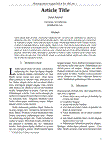| Summary: | Insulin-like peptides are key regulators of metabolism, reproduction, and senescence in higher eukaryotic organisms.They have been described in different invertebrates, including nematodes, molluscs, and insects. Insulin-like peptideshave also been detected in some decapod crustaceans, where they may display typical insulin effects. On the basisthat common biological function may be related to a similar structure, we searched for an insulin-related substance inthe shrimp Litopenaeus vannamei and further investigated its function. An IGF-I-like molecule was detected inneurosecretory cells of the brain and thoracic ganglion in shrimps at different molt stages. Furthermore, wedemonstrated that ILP did not differentially stimulate ecdysteroid secretion as it is observed in some insect species.An in vivo assay was performed and the results revealed that injections of heterologous insulin/IGF-I increased theglycogen contents of gills and digestive gland from intermolt animals (fasting state), suggesting that an endogenousILP may display a conserved function in decapods. Moreover, cloning and sequencing of a cDNA from hemocytesrevealed that the sequence code for a precursor similar to the Insulin-like Growth Factor binding proteins. Aquantitative real-time RT-PCR study revealed the presence of LivIGFBP-related peptide transcript in a variety oftissues, including nervous tissues, gills, and muscle, brain, thoracic ganglion and nerve cord. In addition, theexpression of this transcript differs according to the animal’s size, suggesting a possible role in growth regulation.
|
|---|
